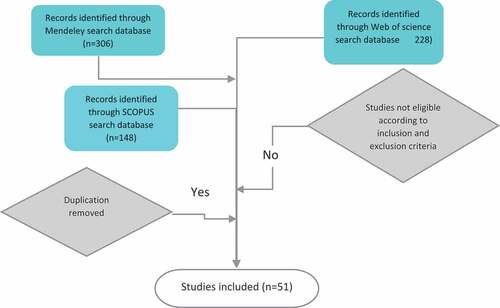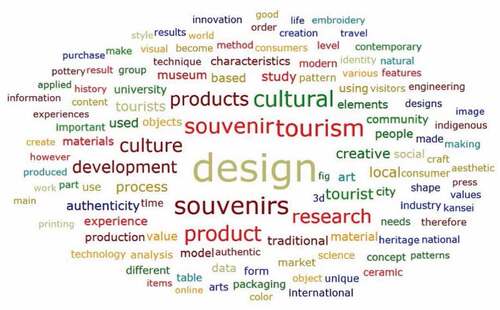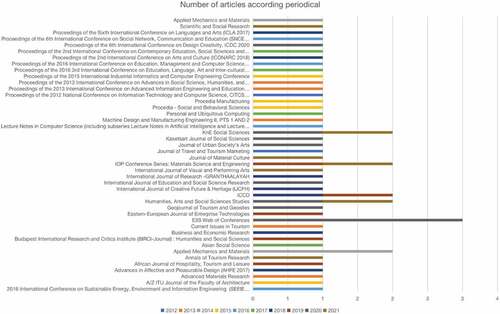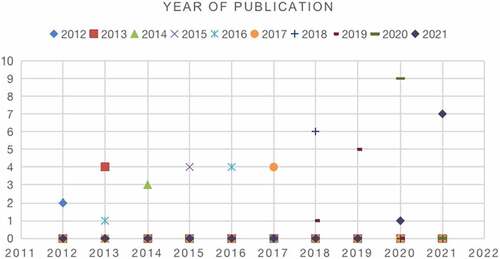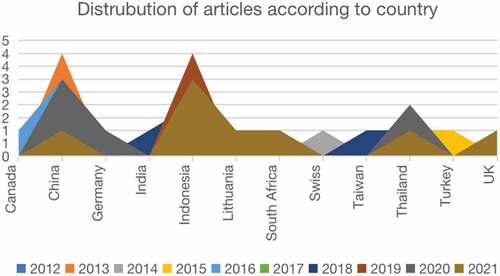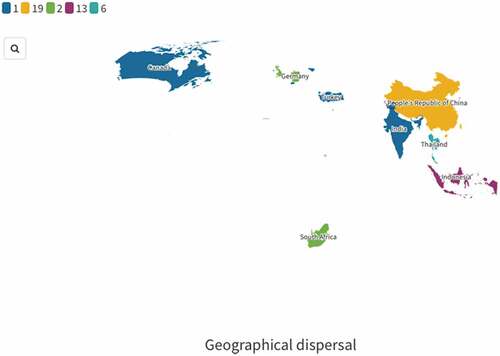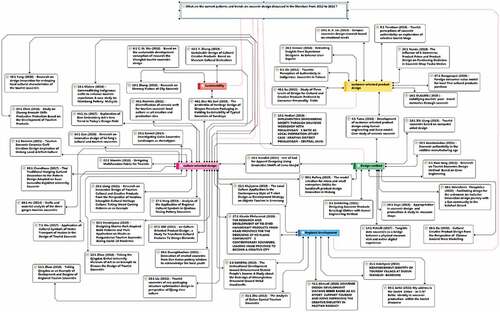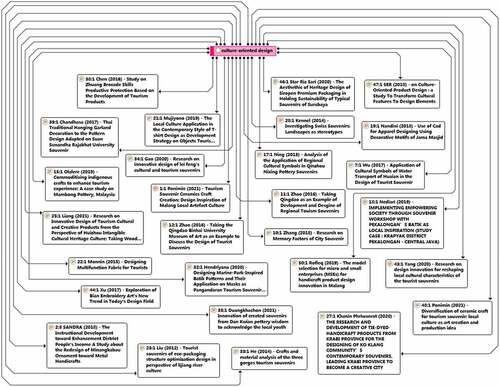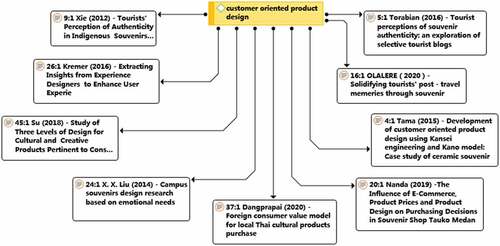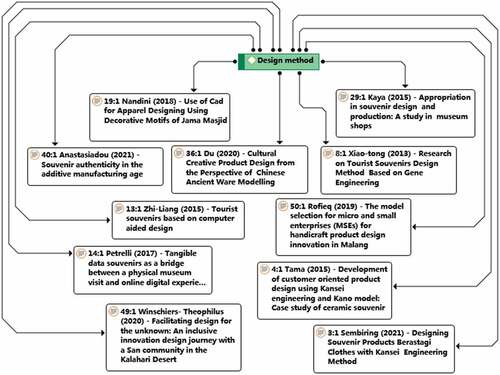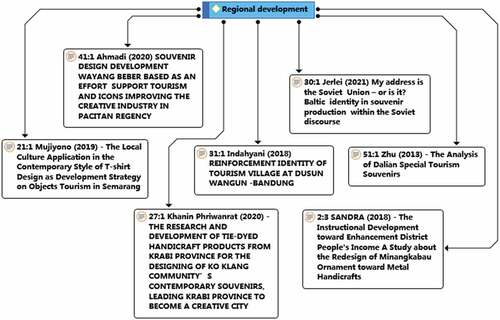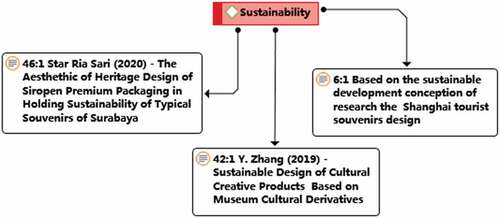Abstract
As cultural tourism expands, globalisation and localisation have become contradictory terms. Souvenirs are fast becoming crucial for promoting cultural tourism while maintaining a pivotal role in enhancing a country’s image. Design is essential for souvenir production and the primary method by which souvenirs create value. Despite the growing number of publications on souvenirs, few reviews examine the development and strategies of souvenir design and its future directions. Therefore, this study’s specific aim is to report on the outcomes of a thematic review analysis examining souvenir research from a design perspective, addressing the knowledge and methods required in practice-based souvenir design. Data for this study were collected using a thematic review analysis of 51 publications from 2012 to 2022, and the ATLAS.ti 8 code-to-document review findings indicate the patterns needed by researchers. The analysis shows five central themes: 1) culture-oriented design; 2) customer-oriented product design; 3) design method; 4) regional development; and 5) sustainability. The results suggest that future research trends in souvenir design should focus on locality-based development strategies and sustainability for promoting local culture and economies. This work will generate fresh insight into new guidelines for research trends in souvenir design.
PUBLIC INTEREST STATEMENT
This paper is a review of the published literature on souvenirs from a design perspective over the last decade, which helps us to understand current patterns in this topic and provides insights for future research.
1. Introduction
Globalisation has recently had a negative effect on heritage values resulting from a systemic interaction of culture with the environment. Meanwhile, the decline in different aspects of traditional culture has turned many cultural objects into outdated stereotypes. However, evidence suggests that cultural products can be transformed into everyday items that meet the needs of today’s consumer market by increasing their original meaning and images (F. E. Olalere, Citation2019). Statista reports that sales by gift, novelty, and souvenir shops in the United States reached approximately $13.6 billion in 2019 and are expected to reach about $16.6 billion by 2024 (Statista, Citation2021, Citation2022).
A souvenir is generally defined as following a pattern based on the purpose of creators, from a variety of opportunities, eras, or places, and made according to the customers’ needs. Souvenirs should help narrate each location and evoke tourists to recall the story and history of a site (Chandhasa, Citation2017). Adopting a similar position, Yang (Citation2020) argues that souvenirs may better reflect the most basic cultural features of a site or town, showing distinctive and irreplaceable features. Anastasiadou & Vettese (Citation2021) point out that souvenirs can also be mass-produced objects that are generally outlined as inexpensive, worthless, and inauthentic (Cave & Buda, Citation2013; Hitchcock, Citation2013; Norman, Citation2004). Hence, authenticity markers verify whether tourist items reflect local culture (Littrell et al., Citation1993; Anastasiadou & Vettese, Citation2021).
Other researchers who have proposed definitions of souvenirs in practice and the literature mainly emphasise that souvenirs serve as physical reminders of a visit, allowing visitors to experience again and remember a memorable moment or location. Souvenirs can be handcrafted products, which are thought to be more artistically superior and authentic representations of local art (Cave & Buda, Citation2013; Anastasiadou & Vettese, Citation2021). More specifically, tourist souvenirs are items acquired by travellers in a tourist destination rich in folklore customs and regional cultural characteristics, and they have a lasting value. Their marketing and sales are a means to promote local culture and traits. Quality souvenirs can boost local economies and preserve and pass down particular cultural artefacts. A distinctive souvenir can only be found at a specific site and is challenging to locate in other areas (Star & Alim Cendekia, Citation2020).
Over the past decade, most research has emphasised that tourist souvenirs in tourist sites worldwide are developed using ideas inspired by local cultures, such as an attractive culture or artefacts that include historical rituals, art, architecture, monuments, statues, and local icons (Ponimin, Citation2021). SER (Citation2018) draws on the work of Lin (Citation2007), who pointed out that integrating culture into items will become a global design trend. Therefore, more thorough knowledge of cross-cultural exchanges is essential for participating in the world market and developing a local design (Zhu, Citation2013).
Overall, souvenirs can contribute to local economic development through tourism, and they are also a representation of the image of a heritage site. As cultural, social, and economic phenomena, souvenirs have become the subject of research in many disciplines. In the literature, souvenirs are seen as part of globalisation, in which the production of symbols is of tremendous value in mass-consumer culture. They have become part of tourist memory, contributing to the visual canonisation of clichés and stereotypes (Kennel & Backhaus, Citation2014). However, all the previously mentioned research papers suffer from some critical limitations. The past research fails to use mature concepts and methodology, and another weakness is that the studies suffer from a lack of well-grounded theoretical considerations. Furthermore, no explanation of literature on design specification can be found, and there is a lack of standardised research method employed for the design area. Design is an essential aspect of souvenir production, and symbol creation requires professional specifications and knowledge related to design. Despite substantial efforts, no review article describes the patterns within souvenir research publications from the design perspective. Hence, the purpose of this study is to examine the patterns and trends in souvenir design literature from 2012 to 2022 to promote future research and determine the orientation of souvenir design for both theoretical and practical applications.
Thus, this work aims to cope with the issues that have been discussed in souvenir design publications between 2012 and 2022 by posing the following research question:
RQ: What are the current patterns and trends in souvenir design publications discussed in the literature from 2012 to 2022?
2. Materials and methods
The primary data sources were retrieved via SCOPUS, Web of Science, and Mendeley searches. Several journals work with Mendeley data to make underlying research data available. Datasets are connected to the article, making it feasible to seek literature in the above mentioned databases.
The theme analysis procedure of using the ATLAS.ti 8 tool in a literature review was introduced by Zairul (Citation2020). Thematic analysis, according to (Clarke & Braun, Citation2013), is the process of detecting patterns and developing themes through extensive reading on a subject. To analyse the trend of souvenir design in publications, the subsequent stage assesses the practice and creates categories. Our overall project aims to examine and assess the results to suggest future souvenir design research.
The articles were selected based on a variety of criteria: 1) published from 2012–2022; 2) containing the keyword souvenir design; 3) focusing on souvenir design issues; 4) written in to English; 5) published in a journal, review article, or proceedings paper in Web of Science or as conference papers in SCOPUS. The literature retrievals were performed using search strings shown in in Mendeley, Web of Science, and SCOPUS literature searches.
Table 1. Search strings from Mendeley, WoS, and Scopus
The term souvenir design was sought in the literature search. In the initial investigation, 682 articles were found in the three databases. The results of a Mendeley search “Souvenir design” AND DOCUMENT TYPE: Journal (119) Year: [2012 TO 2022] yielded 306 articles that discuss souvenir design from 2012 to 2022. In the Web of Science, 228 pieces were found with the term “souvenir design” and English (Language) and Articles or Proceedings Papers or Review Articles (Document Types) Timespan: 2012–01-01 to 2021–12-31 (Publication Date) Editions = A&HCI, BKCI-SSH, BKCI-S, CCR-EXPANDED, ESCI, IC, CPCI-SSH, CPCI-S, SCI-EXPANDED, SSCI. Additionally, the strings of searches used “souvenir” AND “design” AND LANGUAGE (English) AND PUBYEAR > 2011 AND (LIMIT-TO (DOCTYPE, “ar”) OR LIMIT-TO (DOCTYPE, “cp”) OR LIMIT-TO (DOCTYPE, “re”) yielded 148 results in SCOPUS.
Of those articles, 631 documents were dropped because of the use of anecdotes or immature results or because they did not discuss souvenir design topics. In addition, several papers were confirmed to be incomplete, or the complete article was inaccessible, with a fragmented link and duplication, or the metadata were incomplete. Consequently, the overall number of articles that needed to be evaluated dropped to 51 (). These articles were uploaded as primary files into ATLAS.ti 8, and each piece was then categorised by 1) author; 2) journal; 3) publisher; 4) issue number; 5) volume number; and 6) year of publication. Only papers written in English were selected. The final 51 articles were imported in ATLAS.ti 8 for further analysis (See, )
In the qualitative part of the analysis, thematic analysis induction is used to move much of the collected data from specific content to wider generalisations and eventually to theory to ensure that themes are effectively linked to the data (Patton, Citation1990). This process involves coding, categorising, and noticing patterns, that is themes that can be provided at different levels (Clarke, Citation2006).
The findings of this article were obtained from both qualitative and quantitative approaches. The quantitative part presents data based on a numerical perspective, while the qualitative part identifies themes established from selected articles and formulates a theoretical framework for souvenir design.
The study found that the research of souvenirs from a design perspective is still in its infancy and is based mainly on reports of practice-based design. The research methodology lacks paradigm construction, and some research processes lack data evidence. The nature of exploring research related to souvenir design has the advantage of practice and case studies. An assessment of data collection techniques, analysis units, and theoretical frameworks also must be improved. The focus of research in the literature over the last ten years indicates current trends and patterns in the discipline.
3. Results and discussions
The section aims to detail the main findings of the thematic review. This study reviews the patterns and trends of souvenir design publications and research; the results have been divided into quantitative and qualitative sections. The quantitative section begins with a word cloud generated from the analysis of the primary 51 documents. This is followed by an analysis of publication status by year, the number of articles published per periodical, and the geographical distribution by country of publication.
In the subsequent qualitative analysis, trends and patterns generated 12 first codes after reviewing the 51 articles. Following successive rounds of re-coding and code merging in ATLAS.ti 8, five significant themes were ultimately found among the trends and patterns ().
Table 2. Thematic review of souvenir design publications from 2012 until 2022
As mentioned in the introduction, the focus of this article is to understand the lineage of souvenir design. Despite research on the topic, no review articles address the integration and framing of souvenir design in a multidisciplinary intersectional context. The research proposal, from data collection and preparation to interpretation of the results, is based on the findings of recent studies and is defined in a logical sequence.
3.1. Quantitative results
In the preliminary analysis, the largest words appearing in the word cloud indicate a high frequency in the documents; they are “design” and “souvenir”. In , the word cloud from the 51 papers captures the high-frequency words, including “design” (used 2258 times); “souvenirs” was mentioned 1188 times and “tourism” 1139 times, “cultural” and “culture” were mentioned 1016 and 770 times, respectively.
Another of our analyses, shown in , indicates the various journals chosen by souvenir design researchers. According to the report, E3S Web of Conferences is the most popular, with Humanities, Arts and Social Sciences Studies, ICCD, IOP Conference Series: Materials Science and Engineering, and Applied Mechanics and Materials following. As stated earlier, if “souvenirs” was the only keyword used in the search, there would be tens of thousands of articles. However, by focusing the search on “souvenir design”, the results are substantially reduced and targeted, proving that the topic is still in its infancy and that much remains to be explored. Moreover, a gradual increase in the terms “souvenir design” in recent years can also be seen in the analysis; this can be traced to the evolution of the articles, as shown in below.
The geographical dispersion analysis shows that souvenir design research has become popular in China. The results show 19 articles from China, the highest number of publications in the last decade. Many of these studies discuss the relationship between traditional Chinese culture and souvenir design. This can be seen in Ning and Su (Citation2013), who analysed the use of Qinzhou Nixing cultural symbols in pottery souvenirs; Z. Z. Xu (Citation2017) explored the new trend of local art from the design field, and Liang and Qi (Citation2021) proposed a design of tourism cultural products with intangible Huizhou culture. The second highest number of studies, 13, came from Indonesia; several of these focused on craft creation as souvenir design inspiration, such as Ponimin et al. (Citation2021), who pointed out that the Malang local artefact culture could be design inspiration for tourism souvenir ceramics products, and Sandra et al. (Citation2017) proposed using Minangkabau ornaments to redesign metal handicrafts. Another related study by Tama et al.(Citation2015) focused on developing customer-oriented souvenir design using Kansei engineering and the Kano model. Thailand was next, contributing six papers. Some research viewed designing multifunction fabric (Monnin, Citation2015) and tie-dyed handicraft products from the local community to design contemporary souvenirs (Phriwanrat, Citation2020; See, ).
The academic literature on souvenir design reveals several central themes. The original coding yielded 12 characteristics; however, this was reduced to just five themes after merging and renaming. The five themes are culture-oriented product design, customer-oriented product design, design method, regional development, and sustainability. In the next qualitative section, the themes will be examined in depth.
3.2. Qualitative results
Five broad themes emerged from the qualitative analysis, and the details obtained to address the research question will be discussed in this section. The five themes mentioned above were discussed according to the thematic analysis of various papers and their frequency sequence. It is common for these five themes to overlap in the articles presented in this review instead of being found independently. Some pieces include several themes and vice versa. In this section, the specific description of the themes will be shown separately and in more depth to reply to the research question. shows an overview of the souvenir design issue.
What are the current patterns and trends in souvenir design publications discussed in the literature from 2012 to 2022?
3.2.1. Theme 1: Culture-oriented design
presents the results obtained from the preliminary analysis of culture-oriented design. Culture is the most popular theme among souvenir design studies, with 28 articles discussing the issue of design and culture from different focuses such as culture as an inspiration for souvenir design, culture-based product design, the relationship between culture and design, and the redesign process and techniques.
Globalisation has impacted local culture and inevitably brought about a change in traditional decorations; some traditions have been forgotten and are increasingly difficult to see due to the changing surroundings (Chandhasa, Citation2017). Ning and Su (Citation2013) pointed out that modern technology and mass-production have increased the efficiency of handicraft production and, with it, the production of souvenirs. At the same time, handicraft product design innovation is critical because it responds to tourist preferences for particular handicraft products from a given place (Rofieq et al., Citation2019). Fundamentally, design is about improving things for users, customers, businesses, and the wider world (Rodgers & Milton, Citation2011). It is a distinctive act of exploration and activity that seeks to create and adapt systems to meet human needs (Nelson, Citation2004). Hence, the use of local cultural features in design can be a strategy for creating product identity in the global marketplace. Designing products with local features in order to emphasise the cultural value of the product has become a key issue in the design process (T.-Y. Lin, Citation2005, Citation2007; Wu et al., Citation2004). Therefore, redesigning traditional products is only feasible by exploring the cultural elements of the destination and understanding how they can be embodied in new products with appropriate design elements (Rizal et al., Citation2017).
Ponimin et al. (Citation2021) realised that a lack of tourism products based on ceramics and inspired by local culture in the tourism products surrounding the Greater Malang could lead to a loss of memory of the destination among tourists. Therefore, as tourism subjects and creative industry subjects, the crafter could awaken the tourism industry.
In addition, the studies also pointed out that souvenir design faces many challenges. A lack of brand effect has been found by He (Citation2014) in the development of regional tourism product design in the Three Gorges region of China. Zhao et al. (Citation2016) also found in their survey that some current Chinese tourism souvenir products are not creative enough, poorly functional, lack local identity, and do not reflect the tourism characteristics of the destination. Ning and Su (Citation2013) pointed out that there are many fake and shoddy tourist products in the Chinese souvenir market, which has caused price confusion and affected the interests of legitimate manufacturers. Souvenir designs have grown increasingly homogenised, with uninteresting and repetitive pictures failing to spark consumer interest or recall city memories, and this has become a challenge for designers (Z. H. Zhang et al., Citation2018); Nevertheless, the development of the Chinese red revolutionary culture souvenirs is underdeveloped because it is in its infancy (Gao & Han, Citation2020). Although embroidered elements are commonly employed in the design of Chinese tourist souvenirs, there are very few products in the large souvenir marketplaces that are distinctive and unique to Bian embroidery (Z. F. Z. F. Xu, Citation2016). Furthermore, regarding intangible cultural heritage preservation, Chinese Zhuangjin craftsmanship is facing a severe crisis, and scientific methods and advanced means must urgently be adopted for salvage and productive conservation (Chen, Citation2016).
Nandini and Sakshi (Citation2018) believe that collecting decorative motifs of monuments in Jama Masjid and applying them to apparel design and product development will make it possible to better preserve valuable heritage. Although tourism in Pangandaran has faced challenges during the COVID-19 pandemic, the design of the Marine-Park-inspired Batik motifs and their application on masks could be a power boost to tourism in Pangandaran (Hendriyana et al., Citation2020). These studies support the notion that the renewal and redesign of traditional culture promote the deep integration of cultural resources with related industries, thereby achieving sustainable development of the regional economy, culture, and ecology (Y. Z. Y. Z. Wu & Liu, Citation2017).
3.3. Culture—an inspiration for souvenir design
Previous studies of souvenir design have reported that the cultural heritage of a destination could serve as inspiration for souvenir design. Similar research examples include exploring how regional cultural symbols were used in souvenirs in Qinzhou Nixing pottery (Ning & Su, Citation2013) and how tourism souvenirs can be designed with cultural symbols of Huaian water transport in China (Y. Z. Y. Z. Wu & Liu, Citation2017).
Local craft creations
Ponimin et al. (Citation2021) suggest that local craft creations could be identified as an important contributing inspiration for designing souvenirs. To further examine the role of local culture in design, in another study, the author proposed that local culture as a product design idea with unique graphic forms will be noticed by customers as memorable items, and this process will contribute to the development of the creative industry (Ponimin, Citation2021). Duangkhachon (Citation2021) performed a similar study of created souvenirs, applying the knowledge from Dan Kwian original wisdom as creativity and technology to advance contemporary community products.
The role of designers
As early as 2014, He (Citation2014) analysed the craftsmanship and materials used in Three Gorges tourism souvenirs, arguing that designers should positively change the product design idea to combine the complementary characteristics of cultural and artistic elements to be reflected in the souvenir consumption market. This view is supported by Z. Z. Xu (Citation2017) and Yang (Citation2020), whose views emphasise the importance of design and designers in passing on local culture; they argue that designers must first understand history and culture to enhance the cultural quality of their products and meet consumer needs.
Handmade product design innovation
For handmade product design innovation, micro and small enterprises (MSEs) should choose a model in which innovative products designed by Malang Crafts should be coupled with local lettering, pictures, and patterns as symbolic images of the city, creating products that are visually pleasing, distinctive in colour, one-of-a-kind in appearance, and dynamic as well as functional and portable (Rofieq et al., Citation2019). Similarly, the necessity of applying wood carving patterns from Huizhou’s cultural history to the design of cultural and creative items was highlighted in research by Liang and Qi (Citation2021) to build a unique local visual style. Other authors (see, Zhang et al., Citation2018; Zhao et al., Citation2016) have used examples of similar approaches as evidence that local characteristics of cultural tourism souvenir reintegration of design could help promote a tourism economy and cultural industries.
Local decorative motifs
Some researchers (e.g., Chen, Citation2016) have proposed that a specific cultural and tourism product based on local decorative motifs might inject new life into heritage culture and thus better preserve it. Chandhasa (Citation2017) detailed the idea that souvenirs could be made with a patterned design of a traditional Thai hanging garland decoration as another approach to reveal the destination’s history. Z. Xu (Citation2017) mentioned new trends in China Bian embroidery in modern design. She advocated for combining traditional and modern materials and developing fashionable products with a cultural spirit and regional characteristics to promote traditional embroidery innovation and industrial development.
Local craft heritage
Most of the authors are mainly interested in questions concerning local craft heritage integrated into souvenir design. Others believe that landscape and political culture could also be used as a resource for souvenir design to promote regional identity. Kennel and Backhaus (Citation2014) focused on landscape design in souvenir products and further revealed the method of geographical references to Switzerland that were set up through the narrative of the landscape. Enhancing the iconic potential of local communities’ natural and artisanal resources is conducive to creating innovative products of distinctive art complementary tourism (Hendriyana et al., Citation2020). Gao and Han (Citation2020) further described applying China’s red revolutionary culture to marketable souvenirs, providing insights into the practice of using innovative cultural products for red tourism.
Souvenir packaging design
A study conducted by Liu and Zhang (Citation2012) showed that the packaging design of tourist souvenirs of Lijiang culture with a simple visual effect, unique cultural connotation, and eco-packaging and optimisation of structural design could promote souvenir sales. Furthermore, incorporating ecological awareness and producing tourist souvenirs with use and aesthetic value would help promote the rapid growth of tourism in Guilin, China. In the same vein, CitationSari et al. (2020), in their paper, noted that the packaging design with the aesthetic heritage of Siropen Premium should be identified to reflect the classic Surabaya souvenir.
3.2.1.2. Culture-based product design
Most previous studies used practice-based research methods to describe the relationship between culture and souvenir design. Ponimin et al. (Citation2021) explained that the creation of a tourist souvenir includes the development of a design concept, the process of creating a design, and innovation of a ceramic product that embodies the local culture of Malang, followed by verification testing, re-production, and finally improving and analysing the results of the product design idea. In the same way, Sandra et al. (Citation2018) proposed creating a suitable model to transform the cultural symbols of the historical heritage preserved by the artisans, using the Minangkabau ornamental motifs on existing brass castings to create new pieces that are more innovative and competitive.
In Krapyak District, Pekalongan, an experimental workshop program for PKK members was used to conduct a practice-based study and to motivate them to learn more about batik material and its uses and incorporate their expertise into design elements for souvenir conceptual design. Ultimately, the study’s findings will enhance the usage of regional inspiration in souvenirs, thereby preserving batik and conveying it to Indonesia’s younger generation (Nediari et al., Citation2019). Another study proposed the application of indigenous heritage to modern-style T-shirt design as a strategy for destination tourism. Mujiyono (Citation2019) found that successful t-shirt designs produced and marketed were modern in style, with the advantage of combining local symbols or heritage with today’s popular idioms to give a sense of humour, wit, parody, and fun. In this study, the authors suggested that producing t-shirt souvenirs would promote the creative industry of tourist attraction, dynamically adapting to the times in ongoing development to preserve the identity tradition of Semarang City. By following the concepts and procedures used by the inhabitants of Baan Koh Klang, Khanin Phriwanrat (Citation2020) researched and developed tie-dyed handicrafts from the Krabi province for the design of modern souvenirs for the Ko Klang community and explored guidelines for souvenir design, recognising the importance of location with identity, landmarks, and typefaces to establish the Krabi province as a creative site.
3.2.1.3. Redesign process and techniques
The redesign of indigenous culture requires appropriate methods and techniques. Y. Z. Y. Z. Wu and Liu (Citation2017) proposed that at the beginning of design, designers must understand the meaning of local culture, quickly and effectively select cultural resources and elements, then integrate extracted cultural symbols into product design and finally design and develop new products. Zhang et al. (Citation2018) made a case for an alternative design process in which existing products are categorised and individually corresponded to elements in urban memory. The acceptance of the entire creation is then analysed using questionnaires and interviews. These statistical analyses summarise the practical aspects of different urban memories. Finally, the design process for an honourable case is listed to provide a more credible approach to urban souvenir design.
To investigate and explain how cultural characteristics can be applied to design elements through a project-based approach, SER (Citation2018) claimed that the Cross-Culture Design Model could be used to create items, and the design of a culture-oriented product could be employed as their research method.
Several studies take a design technology perspective. For example, Nandini and Sakshi (Citation2018) presented the idea that it is feasible to use computer-aided design (CAD) to design textiles and garments that combine well-known local architectural motifs. Patterns can be created using various compositions and then applied to fabrics through printing techniques, weaving, and embroidery. This type of research could be effective in helping to preserve the motifs of monuments. In another practice study, Duangkhachon (Citation2021) also used the wisdom of Dan Kwian pottery to create souvenirs; 3D technology was used to print ceramics and create innovation, and packaging designs sold the clay souvenirs to convey knowledge to young people in the community. Thus, they could produce a new product with their local identity combined with wisdom.
3.3.0.3. Culture-oriented design
In the field of design, culture is essential. Adding cultural value to a product generates the core of its value, and design can work as a facilitator for cultural development (Lin, Citation2007). In his studies, the author developed a model for a cultural product design that illustrated the process of transforming local cultural identities, creating new products that satisfy the demands of today’s consumer markets by reinforcing their original meaning and using new production technologies, providing a valuable experience for designers by creating successful cross-cultural products. Consequently, designers could gain a comprehensive awareness of the relationship and interaction between design and culture in the context of teamwork. The communication of design and culture is a crucial issue as interdisciplinary studies become more relevant for design in the “Glocalisation” setting, leading to in-depth research of “Culture-oriented Product Design” (SER, Citation2018). He further proposed that the translation of cultural identity into design elements could produce a culture-oriented product design. However, in recent years, few authors have focused on practice-based research, which has been conducted as a visual communication discipline within graphic design.
Most of these articles are based on an examination of design practice, and they only show what design products present without informing us about how to conduct design research. In conclusion, there is a current paucity of high-quality research in the design field to further deduce culture-oriented design ideas. The next section of the analysis covers customer-oriented product design.
3.3.1. Theme 2: Customer-oriented product design
Another reported theme is customer-oriented product design (). The needs of consumers have been identified as another important factor to consider in the design of souvenir products. The understanding of designers about specific user features and their culture could ensure that a product succeeds and lasts longer (Ahmad Rizal Abdul Rahman, Citation2014). Tama et al. (Citation2015) used the Kansei Engineering with Kano Model to contribute to ceramic souvenirs’ design to better fulfil customers’ needs. Kansei Engineering was used to solicit buyers’ perceptions and transfer them into design elements. The Kano Model was then applied to classify or categorise Kansei terms from customers’ perceptions to attributes, therefore benefitting calculation and statistics. In the future, critical Kansei words that affect customer satisfaction will be design objectives. This study indicates the characteristics that influence customers’ perceptions of ceramic objects; these may be divided into two types: appearance and performance factors.
Torabian and Arai (Citation2016) used constructivist grounded theory to examine travel blog posts to learn the details of travellers’ opinions on souvenirs’ authenticity. He proposed that handicrafts were initially designed to meet the needs of the community, and pottery was initially designed to meet the community’s need to carry water and store food; however, the promotion of tourism changed the function and form of artefacts, and crafters started to alter their works according to tourists’ needs. Tourists’ perceptions of souvenirs are primarily based on their visual appeal, and their propensity to purchase is also linked to design authenticity (Xie et al., Citation2012). The study contributed to the understanding of Taiwanese tourists’ perceptions of the local souvenirs’ authenticity through the evaluation, design, and production of souvenir cups that symbolise Taiwan’s indigenous Paiwan culture. In addition, markers, patterns, and materials were examined and chosen to test tourists’ impressions of authenticity.
Moreover, in experimental research using the Conceptual Cultural Design Model, Olalere (Citation2019) examined how local heritage can be integrated into products that boost tourist satisfaction by reshaping chosen handicraft pottery goods into souvenirs that promote cultural traits to tourists and express the importance of tourist attraction to potential visitors. Souvenirs can be created to promote tourist locations and attractions. His further study supports this view. A survey was also conducted by Folasayo E. Olalere (Citation2021) that examined the factors that influence tourist souvenir purchase preferences. According to research, by incorporating product features that satisfy the intangible images of visitors’ interactions or perceptions throughout their travels, souvenirs can play a crucial role in boosting cultural influences, expressing the essence of tourism to potential tourists and allowing tourists to relive the daily time and space experience. Additionally, Nanda (Citation2019) investigated the reasons for the decline in consumer purchases in Tauco Medan, identifying and analysing the e-commerce effect, cost, and design of products in consumer purchase-making. Furthermore, applying the principle of heterogeneous isomorphism to explain the interaction between emotional needs design and process in the design stage of campus souvenirs can be an effective solution to design problems (Xinxiong et al., Citation2014).
Anastasiadou and Vettese (Citation2021) demonstrated how tourists in the heritage area’s souvenir design process through additive manufacturing might affect the customers’ views on souvenir authenticity and significance. A study on three-level design for the relevance of customer persona attributes for creative and cultural products was also implemented by Su et al. (Citation2018). The article explores the relevance of customer characteristics in product selection. Hence, to satisfy customers’ desires, creative and cultural products emphasise the development of individualistic items to meet non-traditional and independently emotional consumer needs.
Correspondingly, the extraction of insights from experience designers was also beneficial in improving user experience design, which aims to create meaningful experiences that summarise users’ expectations, perceptions, and evaluations of a product, linking product and lifestyle attributes to better connect users and outcomes by helping develop souvenirs (Kremer & Lindemann, Citation2016). Dangprapai et al. (Citation2020) also found that items with tampered visual references of the host culture do not meet consumer needs. Hence, it is necessary to investigate the patterns of values that tourists perceive when purchasing products to understand the significance of transactional product values in the souvenir design process. Next, the design method theme will offer more detail.
3.3.2. Theme 3: Design method ()
3.3.2.1. The engineering method
This section is concerned with the design method. One method used to design products is Kansei Engineering, a system of assessments based on feelings to produce a fundamental component.
As early as the 1970s, Mitsuo Nagamachi was one of the first to examine Kansei as an engineering method that integrates sensitivity and sensations through hearing, vision, taste, smell, and touch. This method is often used to convert consumer demands into product characteristics based on psychological experiences (Schütte, Citation2005). In recent years, Kansei Engineering has been used to design various products. For example, Tama et al. (Citation2015) conducted a case study of ceramic souvenirs to develop customer-oriented product design employing the Kansei Engineering with Kano Model. Kansei Engineering was used to collect consumer perception and transfer it into design elements in this study, which was undertaken to promote the ceramic souvenir design and better fulfil the customers’ needs. Similarly, Sembiring et al. (Citation2021) identified consumer-preferred Kansei, objects, and product categories using Kansei engineering. In this study, the author used four questionnaires to point out the market need for the look and design of local clothes.
3.3.2.2. Gene engineering
Gene engineering was proposed by Xiao-tong et al. (Citation2013) as an alternative approach to tourism souvenir design. The cultural genetic code, according to the author, offers essential guidance for a design platform based on the genes of culture. A new approach of design called pan-ethnic design is proposed based on tourism souvenirs.
3.3.2.3. Cultural design model
Using Lin’s conceptual cultural design model pointed out in 2007, F. E. Olalere (Citation2019) employed a case study on the Mambong pottery of Malaysia to extract cultural characteristics and translate them into modern souvenirs that adapt to current consumer needs and visitor desires. Further, Olalere (Citation2021) strengthened the knowledge base by improving the cultural product design model in souvenir objects. The Cultural Product Design Model is a framework proposed by Lin in 2006 that combined the levels, layers, and design characteristics of culture to help design products culturally and aesthetically appropriate for society and to satisfy consumers. The Cultural Product Design Model is composed of three key stages: the conceptual model, the research methods, and the design process, which aims to extract cultural characteristics and develop those traits in a design model.
3.3.2.4. Computer-aided design
Another approach to designing souvenirs was through CAD, using architectural motifs from various famous destinations in textile and clothing designs that can be used as souvenirs. These patterns could be engraved, silkscreened, weaved, digitally printed, and embroidered into fabrics in a variety of design compositions. The patterns of the landmarks will be preserved when they have been applied to the product as a result of this research (Nandini & Sakshi, Citation2018).
3.3.2.5. Appropriation strategies
The appropriation strategies mentioned by Kaya and Yağiz (Citation2015) could also be used as a framework for analysing design decisions, providing craftsmen and designers with a critical awareness of souvenir design procedures. The researcher selected a sample of six famous museums’ shops in Istanbul and Izmir to evaluate the collection of physical features and intended functions of their content to assess the appropriation techniques used in the making of over-the-counter souvenirs in a study of the product characteristics of souvenir design from the standpoint of retailers and consumers.
3.3.2.6. Additive manufacturing
As a new form of production or replication, additive manufacturing or 3D printing disturbs pre-existing social consumption habits and undermines the existing souvenirs as tangible, metaphorical, and iconic products that frequently challenge authenticity. Anastasiadou and Vettese (Citation2021) demonstrated the use of additive manufacturing technology for engaging tourists in the design decisions of cultural items and how it impacts tourists’ views of their authenticity and significance in their paper.
3.3.2.7. Co-design
Community-based co-design has been combined with the inclusion creation method, which Winschiers-Theophilus et al. (Citation2020) leveraged to create a series of refrigerator magnet keepsakes employing an augmented reality approach to conceptualise the unknown. The goal of this research was to analyse different structural model alternatives to find the optimal model by identifying client desires using the Partial Least Square (PLS) approach. An ideal structural model among the options provided for micro and small enterprises (MSEs) to design handmade items founded on historical values, native culture, and customer demands is presented in the study by Rofieq et al. (Citation2019).
Design methods and processes are important content in souvenir design research. In the final section, we will discuss the creation of souvenirs aimed at regional development.
3.3.3. Theme 4: regional development
Analysis shows that souvenir design is one strategy for regional development (). With the increase in visitors, the necessity for mass-produced souvenirs has increased. Several authors (e.g., Olalere, Citation2019; Ponimin, Citation2021) have considered the commercialisation of indigenous crafts with the coding of cultural identity in design practices to sustainably conserve heritage values, enhance the tourist experience, and enable local communities to profit from the production and sale of souvenirs. The use of indigenous culture in contemporary design could not only increase the income of regional people (Sandra et al., Citation2018) but also be used as a development strategy for the destination (He, Citation2014; Mujiyono, Citation2019). For instance, when foreign tourists wear a souvenir that reflects Thai identity in terms of colour and pattern, it could be beneficial in promoting tourism in Thailand by meeting the tourist’s usage and emotional aesthetic needs (Monnin, Citation2015). Similarly, souvenirs could help guide a location to be a creative city (Phriwanrat, Citation2020) and implement an empowering society through souvenir workshops (Nediari et al., Citation2019). In addition, souvenir design facilitates the preservation and development of cultural heritage (Chen, Citation2016; Liang & Qi, Citation2021).
It is evident that souvenirs can solidify the post-travel memories of tourists, presenting a good opportunity for the destination. By marketing potential locations or attractions like ecotourism inside local areas through souvenir design, traditionally overlooked communities can benefit from these business choices while also promoting development in local remote regions (Olalere, Citation2021). The application of local culture in a modern style T-shirt design could be a development strategy for tourism in Semarang, as presented by Mujiyono (Citation2018), as it could create an impression of wit, humour, parody, and fun by combining local icons or traditions with current popular idioms, enhancing creative industries in tourist attractions and keeping the local identity traditions. Sandra et al. (Citation2018) also presented the idea that the Minangkabau decoration redesign around metal crafts could be instructional development for increasing the income of district people. The authors believed that one of the key business opportunities in the free-trade age is the development of household businesses that make souvenirs in West Sumatera. The goals for improving the bass cast items at Sungai Puar cannot be isolated from the development of tourism products and service areas. A current framework could optimise existing resources to boost the economy and citizens’ qualify of life. A similar point was made by Phriwanrat (Citation2020), who explored the technologies and procedures of tie-dyed fabrics from Krabi Province to use in created souvenirs, with benefits for communities, society, and commercial value, as well as helping in the evolution of the destination into a creative city.
Jerlei (Citation2021) used the identification of Baltic souvenirs as a case study to determine the existence and nature of regionalism inside the Soviet system. The one-of-a-kind souvenirs contributed to the tourist identity of the village, which could encourage more visitors to come to the area and buy memorable souvenirs made by locals and inspired by coffee—the best product of the village—to develop the community’s well-being and promote the coffee farms’ sustainability (Indahyani et al., Citation2018). Zhu (Citation2013) analysed the issues of design and product promotion in the current tourist souvenir market of Dalian and discussed ways to enhance the design and development ideas of local tourist souvenirs to raise the destination profile. Ahmadi et al. (Citation2020) considered that the development of souvenir designs based on attractions in Wayang Beber helped the creative industry grow in the artisan sector in Pacitan. By elevating Wayang Beber as a classic Pacitan cultural icon while pondering and overcoming challenges for promoting tourism development, the fundamental principle of making decorative motifs and applying them to various types and forms of souvenirs might be a measurement of the authenticity of tourist identity.
The importance of souvenir design has been gradually revealed in the first four themes, and in the following theme, the embodiment of sustainability in souvenir design research will be analysed.
3.3.4. Theme 5: sustainability
Sustainability refers to satisfying current development demands while having no impact on the future development needs of generations. Sustainable products can adapt to various circumstances, which is a challenge in the design of tourist products. C. M. Wu and Li (Citation2013) discovered common issues with Shanghai tourist souvenirs in their research. They propose a sustainable concept that would implement new resources for Shanghai tourist souvenir design and do so sustainably by using recyclable materials and engaging in disassembly, reusability, and maintainability to promote the development of souvenir design. The Conceptual Cultural Design Model is employed by Olalere (Citation2019) in experimental research to develop selected indigenous handicrafts into tangible media that encourage tourists to engage with cultural features while also expressing the spirit of the destination to potential visitors. This is a feasible strategy for boosting tourism and a sustainable method for preserving local crafts and providing business opportunities ().
Furthermore, in response to the variable quality of souvenirs in Chinese museums and the under-utilisation of cultural resources, Zhang (Citation2019) proposes the application of the “Preaching March” approach and concept of sustainable design to the Terracotta Warriors Museum’s creative product, providing a viable approach for cultural and innovative product design and using design to track the idea of sustainable development.
In addition, a heritage idea with a Dutch European aesthetic for Siropen Premium souvenir packaging can help the cultural sustainability development of Dutch colonial times in local products and remind visitors that local souvenir packages have European culture attributed to society’s indigenous culture. Siropen souvenirs, typical of the Dutch era, reintroduce Dutch culture from the colonial period (Star & Alim Cendekia, Citation2020).
Therefore, future publication topics on souvenir design should focus on locality-based development strategies and sustainability to promote local culture and economies. Most evidence noted above shows that destination culture can be integrated as an inspirational resource for souvenir design by targeting regional development. At the same time, consumer demand must be satisfied, and innovations in design methods will improve the effectiveness of implementation. All these efforts will help establish the specifications, appropriate research methodology, and theoretical guidelines to fulfil the maximum potential of souvenir design for cultural and community sustainability.
4. Conclusion and future study
Two approaches were used in this paper to review the 51 articles about souvenir design issues from 2012 to 2022. The results of the data analysis respond to the research question regarding which patterns and trends are found in souvenir design publications from 2012 to 2022. The first approach is a quantitative section highlighting data obtained from the ATLAS.ti 8 figures. The result shows that, despite the growing attention on the topic, no review articles have been proposed in the literature that would cut through the design lens into souvenir research. In the qualitative review, we found that the current trend in literature focuses on culture as an inspiration for souvenir design, and, combined with appropriate methods and techniques, creates products that meet consumer desires, all of which are part of the strategy for local development. The articles have shown some flaws such as fragmented concepts, a lack of theoretical framework and research methods, and a focus on practice-based rather than research-based methods, which may be the main reasons for the insufficient souvenir design research. In summary, this article highlights that cultural sustainability, exploring customer needs, and advanced design methods are likely to become a trend that souvenir design might strive for in the next few years. A significant opportunity is provided to future scholars with a research-based approach to focus on souvenirs from a design perspective.
Acknowledgements
The authors would like to acknowledge Associate Professor Dr Ahmad Rizal Abdul Rahman as her supervisor for his invaluable comments on the theoretical framework.
Disclosure statement
This paper is a review of the published literature on souvenirs from a design perspective over the last decade, which helps us to understand current patterns in this topic and provides insights for future research. No potential conflict of interest was reported by the author(s).
Additional information
Funding
Notes on contributors

Ahmad Rizal Abdul Rahman
My group and my main research focus is on the relationship between culture and design, and the research reported in this paper is part of my PhD study.
References
- Ahmadi, A., Murfianti, F., Candra, D. A., & A, N. R. (2020). Souvenir design development Wayang Beber based as an effort support tourism and icons improving the creative industry in pacitan regency. International Journal of Education and Social Science Research, 3(6), 88–23. https://doi.org/10.37500/IJESSR.2020.3607
- Anastasiadou, C., & Vettese, S. (2021). Souvenir authenticity in the additive manufacturing age. Annals of Tourism Research, 89(C), 1–13. https://doi.org/10.1016/j.annals.2021.103188
- Braun, V., & Clarke, V. (2006). Using thematic analysis in psychology . (Qualitative Research in Psychology, 3(2), 77–101. https://doi.org/10.1191/1478088706qp063oa
- Cave, J., & Buda, D. (2013). Souvenirs as Transactions in Place and Identity: Perspectives from Aotearoa New Zeland. Tourism and Souvenirs: Glocal Perspectives from the Margins, 33, Channel View Publications, 98–117. https://doi.org/10.21832/9781845414078-008.
- Chandhasa, R. (2017). Thai traditional hanging garland decoration to the pattern design adapted on Suan Sunandha Rajabhat University Souvenir. Asian Social Science, 13(7), 131. https://doi.org/10.5539/ass.v13n7p131
- Chen, X. (2016). Study on Zhuang Brocade skills productive protection based on the development of tourism products. 2016 International Conference on Sustainable Energy, Environment and Information Engineering, 88–92. 10.12783/dteees/seeie2016/4503
- Clarke, V., & Braun, V. (2013). Teaching thematic analysis: Overcoming challenges and developing strategies for effective learning. The psychologist, 26(2),120–123. https://doi.org/10.4135/9781412963909.n451
- Dangprapai, A., Cholachatpinyo, A., & Padgett, I. (2020). Foreign consumer value model for local Thai cultural products purchase. Kasetsart Journal of Social Sciences, 41(2), 434–440. https://doi.org/10.34044/j.kjss.2020.41.2.14
- Duangkhachon, K. (2021). Innovation of created souvenirs from Dan Kwian pottery wisdom to acknowledge the local youth. Humanities, Arts and Social Sciences Studies, 21(1), 43–55. https://doi.org/10.14456/hasss.2021.5
- Gao, H. H., & Han, L. (2020). Research on innovative design of lei feng’s cultural and tourism souvenirs. E3S Web of Conferences, 179. https://doi.org/10.1051/e3sconf/202017902021
- He, G. Q. (2014). Crafts and material analysis of the three gorges tourism souvenirs. Applied Mechanics and Materials, 584– 586(2014) , 1103–1110. https://doi.org/10.4028/www.scientific.net/AMM.584-586.1103
- Hendriyana, H., Kudya, K., & Atamtajani, A. S. M. (2020). Designing marine-park-inspired batik patterns and their application on Masks as Pangandaran tourism Souvenirs during Covid-19 pandemic. Journal of Urban Society’s Arts, 7(2), 74–82 .https://doi.org/10.24821/jousa.v7i2.4502
- Hitchcock, M. (2013). Souvenirs and cultural tourism, In Smith, Melanie&Richards, Greg. The Routledge handbook of cultural tourism (pp. 226–231). Routledge.
- Indahyani, T., Sofiana, Y., & Yuniarso, A. (2018). REINFORCEMENT IDENTITY OF TOURISM VILLAGE AT DUSUN WANGUN -BANDUNG. ICCD, 1(1), 290–294. https://doi.org/10.33068/iccd.vol1.iss1.44
- Jerlei, T. (2021). My address is the Soviet Union – Or is it? Baltic identity in souvenir production within the Soviet discourse. Journal of Material Culture, 26(2), 122–141. https://doi.org/10.1177/13591835211052465
- Kaya, Ç., & Yağiz, B. (2015). Appropriation in souvenir design and production: A study in museum shops. A/Z ITU Journal of Faculty of Architecture, 12(1), 127–146.
- Kennel, C., & Backhaus, N. (2014). Investigating Swiss souvenirs: Landscapes as stereotypes. Souvenirs are part of a globalized, mass‐consumer culture in which symbol production plays an important role. symbols used in souvenir design become part of public memory, fostering stereotypes and the visual canonization of clichés. They Embody Both Conc, CULTHIST ’14 Cultural History and Anthropology Conference on Symbols, Representation, Expression in the History of Culture, 36–51.
- Kremer, S., & Lindemann, U. (2016). Extracting insights from experience designers to enhance user experience design. InInternational Conference of Design, User Experience, and Usability , 9746, Springer, 304–313. 10.1007/978-3-319-40409-7_29
- Liang, Y., & Qi, Z. (2021). Research on Innovative design of tourism cultural and creative products from the perspective of Huizhou intangible cultural heritage culture: taking wood carving patterns as an example. Scientific and Social Research, 3(3), 228–232. https://doi.org/10.36922/ssr.v3i3.1189
- Lin, R. T. (2005). Creative learning model for cross cultural product (in Chinese). Art Appreciation, 1(12), 52–59.
- Lin, R. T. (2007). Transforming Taiwan aboriginal cultural features into modern product design: A case study of a cross-cultural product design model. International Journal of Design, 1(2), 45–53.
- Littrell, M. A., Anderson, L. F., & Brown, P. J. (1993). What makes a craft souvenir authentic? Annals of Tourism Research, 20(1), 197–215. https://doi.org/10.1016/0160-7383(93)90118-M
- Liu, Z., & Zhang, Y.-T. (2012). Tourist souvenirs of eco-packaging structure optimization design in perspective of Lijiang river culture. Proceedings of the 2012 National Conference on Information Technology and Computer Science, CITCS 2012, 966–968.
- Monnin, J. (2015). Designing multifunction fabric for tourists. Procedia - Social and Behavioral Sciences, 197(February), 1436–1442. https://doi.org/10.1016/j.sbspro.2015.07.091
- Mujiyono. (2018). The local culture application in the contemporary style of T-shirt design as development strategy on objects tourism in Semarang. In U. Utomo, Suharto, E. Sugiarto, Triyanto, & P. Astuti (Eds.), PROCEEDINGS OF THE 2ND INTERNATIONAL CONFERENCE ON ARTS AND CULTURE (ICONARC 2018) (Vol. 276, pp. 159–162). ATLANTIS PRESS.
- Mujiyono, M. (2019). The local culture application in the contemporary style of T-shirt design as development strategy on objects tourism in Semarang. Proceedings of the 2nd International Conference on Arts and Culture (ICONARC 2018), 271(Iconarc 2018), 159–162. https://doi.org/10.2991/iconarc-18.2019.93
- Nanda, N. N. (2019). The influence of E-Commerce, product prices and product design on purchasing decisions in Souvenir shop Tauko Medan. Budapest International Research and Critics Institute (BIRCI-Journal): Humanities and Social Sciences, 2(3), 388–395. https://doi.org/10.33258/birci.v2i3.439
- Nandini, & Sakshi. (2018). Use of cad for apparel designing using decorative motifs of jama masjid. International Journal of Research -granthaalayah, 6(11) , 345–349. https://doi.org/10.29121/granthaalayah.v6.i11.2018.1137
- Nediari, A., Indahyani, T., & Maryani, M. (2019). implementing empowering society through souvenir workshop with pekalongan’s batik as local inspiration (study case : Krapyak district Pekalongan - Central JAVA). ICCD, 2(1), 376–380. https://doi.org/10.33068/iccd.vol2.iss1.235
- Nelson, H. G. (2004). A whole systems design approach to decentralized governance for human development. United Nations Development Programme.
- Ning, S. Q., & Su, C. Q. (2013). Analysis of the application of regional cultural symbols in Qinzhou Nixing Pottery Souvenirs. In Y. Kim (Ed.), Proceedings Of The 2013 International Conference On Advances In Social Science, Humanities, And Management (Vol. 43, Issue International Conference on Advances in Social Science, Humanities, and Management (ASSHM), pp. 301–306).
- Norman, D. A. (2004). Emotional design: Why we love (or hate) everyday things. Civitas Books.
- Olalere, F. E. (2019). Commoditising indigenous crafts to enhance tourism experience: A case study on Mambong pottery, Malaysia. African Journal of Hospitality, Tourism and Leisure, 8(4), 1–11.http//:www.ajhtl.com
- Olalere, F. E. (2021). Solidifying tourists’ post-travel memories through Souvenir. Geojournal of Tourism and Geosites, 33(4), 1456–1461. 10.30892/gtg.334spl02-593
- Patton, M. Q. (1990). Qualitative evaluation and research methods. SAGE Publications, inc.
- Phriwanrat, K. (2020). The research and development of tie-dyed handicraft products from Krabi province for the designing of Ko Klang community’s contemporary souvenirs, leading Krabi province to become a creative city. Humanities, Arts and Social Sciences Studies, 20(1), 119–137. https://doi.org/10.14456/hasss.2020.6
- Ponimin, Isa, B. B., & Sari, A. A. (2021). Tourism Souvenir ceramics craft creation: Design inspiration of Malang local artefact culture. In International Conference on Art, Design, Education and Cultural Studies (ICADECS), KnE Social Sciences, 288–294. https://doi.org/10.18502/kss.v5i6.9213
- Ponimin, P. (2021). Diversification of ceramic craft for tourism souvenir: Local culture as art creation and production idea. International Journal of Visual and Performing Arts, 3(1), 33–42. https://doi.org/10.31763/viperarts.v3i1.276
- Rahman, A. R. A., and Dolah, M. S. (2014). Culturally Localised Product Design: Unchanged Values. STEdex ‘14: Sustainable Tropical Environmental Design Exhibition, 6 ,Universiti Putra Malaysia Press, 236–241. http://psasir.upm.edu.my/id/eprint/33411.
- Rizal, A., Rahman, A., & Abedini, A. (2017). DESIGN ELEMENTS REGARDING TO CULTURAL FACTORS OF IRANIAN CARPET. International Journal of Sustainable Tropical Design Research/ Alam Cipta, 10(1), 17–22.
- Rodgers, P., & Milton, A. (2011). Alex Milton, Paul Rodgers product design, 2, 240. https://www.academia.edu/35908290/Alex_Milton_Paul_Rodgers_Product_Design
- Rofieq, M., Soeparman, S., Sugiono, S., & Herminingrum, S. (2019). The model selection for micro and small enterprises (MSEs) for handicraft product design innovation in Malang. Eastern-European Journal of Enterprise Technologies, 2(3–98), 60–66. 10.15587/1729-4061.2019.156850THE.
- Sandra, Y., Kamal, M. N., Jupriani, J., & Ariusmedi, A. (2017). The instructional development toward enhancement district people’s income a study about the redesign of minangkabau ornament toward metal handicrafts. In Atmazaki, Y. Rozimela, Jufrizal, Indrayuda, D. Anwar, S. Fatimah, H. Ardi, & M. A. Arianto (Eds.), PROCEEDINGS OF THE SIXTH INTERNATIONAL CONFERENCE ON LANGUAGES AND ARTS (ICLA 2017) (Vol. 148, pp. 268–275). ATLANTIS PRESS.
- Sandra, Y., Kamal, M. N., & Jupriani, A. (2018). The instructional development toward enhancement district people’s income:A In Sixth International Conference on Languages and Arts (ICLA 2017), 148,Atlantis Press, 268–275. (http://creativecommons.org/licenses/by-nc/4.0/
- Schütte, S. (2005). Engineering emotional values in product design: Kansei engineering in development (Doctoral dissertation, Institutionen för konstruktions-och produktionsteknik).
- Sembiring, N., Febrilliandika, B., Oktaviani, H., Siregar, L. S., & Azmi, N. N. (2021). Designing Souvenir products Berastagi clothes with Kansei engineering method. IOP Conference Series: Materials Science and Engineering, 1115(1), 012017. https://doi.org/10.1088/1757-899X/1115/1/012017
- SER, S. (2018). On culture-oriented product design : A study to transform cultural features to design elements. International Journal of Creative Future & Heritage (IJCFH), 6(2), 163–197. https://doi.org/10.47252/teniat.v6i2.198
- Star, R. S. D., & Alim Cendekia, D. (2020). The aesthethic of heritage design of siropen premium packaging in holding sustainability of typical Souvenirs of Surabaya. KnE Social Sciences 2020, 145–161. https://doi.org/10.18502/kss.v4i12.7591
- Star Ria Sari D, Alim Cendekia D and S. (2020). The Aesthethic of Heritage Design of Siropen Premium Packaging in Holding Sustainability of Typical Souvenirs of Surabaya. KSS, 10.18502/kss.v4i12.7591
- Statista. (2021). Industry revenue of “gift, novelty and souvenir stores“ in the U.S. 2012-2024. https://www.statista.com/forecasts/311127/gift-novelty-and-souvenir-stores-revenue-in-the-us
- Statista. (2022). Gift, novelty, and souvenir store sales in the United States from 1992 to 2020. https://www.statista.com/statistics/197723/annual-gift-and-souvenir-store-sales-in-the-us-since-1992/
- Su, W.-Z., Lin, P.-H., & Han, F.-N. (2018). Study of three levels of design for cultural and creative products pertinent to consumer personality traits. Business and Economic Research, 8(2), 193. https://doi.org/10.5296/ber.v8i2.12878
- Tama, I. P., Azlia, W., & Hardiningtyas, D. (2015). Development of customer oriented product design using Kansei engineering and Kano model: case study of ceramic souvenir. Procedia Manufacturing, 4(2015), 328–335. https://doi.org/10.1016/j.promfg.2015.11.048
- Torabian, P., & Arai, S. M. (2016). Tourist perceptions of souvenir authenticity: An exploration of selective tourist blogs. CURRENT ISSUES IN TOURISM, 19(7), 697–712. https://doi.org/10.1080/13683500.2013.820259
- Winschiers-Theophilus, H., Virmasalo, V., Samuel, M. M., Stichel, B., & Afrikaner, H. E. (2020). Facilitating design for the unknown: An inclusive innovation design journey with a San community in the Kalahari Desert. Proceedings of the 6th International Conference on Design Creativity, ICDC 2020, 263–270. https://doi.org/10.35199/ICDC.2020.33
- Wu, T.-Y., Hsu, C.-H., & Lin, R. (2004). The study of Taiwan aboriginal culture on product design. Proceedings of Design Research Society International Conference. Paper, 238, 377–394.
- Wu, C. M., & Li, P. (2013). Based on the sustainable development conception of research the Shanghai tourist souvenirs design. Advanced Materials Research, 753– 755, 1553–1556. https://doi.org/10.4028/www.scientific.net/AMR.753-755.1553
- Wu, Y. Z., & Liu, P. (2017). Application of cultural symbols of water transport of huaian in the design of tourist souvenir. In E. McAnally, Y. Zhang, R. Green, & I. Tretyakova (Eds.), Proceedings Of The 2nd International Conference On Contemporary Education, Social Sciences And Humanities (ICCESSH 2017) (Vol. 124, Issues 2nd International Conference on Contemporary Education, Social Sciences and Humanities (ICCESSH), pp. 410–412).
- Xiao-tong, Z., Chao, J., Li-ling, C., & Jun-jie, G. (2013). Research on tourist souvenirs design method based on gene engineering. In K. Kida (Ed.), Machine Design And Manufacturing Engineering II, PTS 1 And 2 (Vol. 365–366, pp. 1274–1277). TRANS TECH PUBLICATIONS LTD. https://doi.org/10.4028/www.scientific.net/AMM.365-366.1274
- Xie, P., Wu, T., & Hsieh, H.-W. (2012). Tourists’ perception of authenticity in indigenous souvenirs in Taiwan. Journal of Travel & Tourism Marketing, 29(5), 485–500. https://doi.org/10.1080/10548408.2012.691400
- Xinxiong, L., Lin, G., & Haiping, Z. (2014). Campus souvenirs design research based on emotional needs. In W. P. Sung & R. Chen (Eds.), FRONTIERS OF MANUFACTURING AND DESIGN SCIENCE IV, PTS 1-5 (Vol. 496–500, pp. 2616–2620). TRANS TECH PUBLICATIONS LTD. https://doi.org/10.4028/www.scientific.net/AMM.496-500.2616
- Xu, Z. F. (2016). Exploration of Bian embroidery art’s new trend in today’s design field. In E. McAnally, T. Volodina, Q. Chen, Y. Zhang, & I. Solovjeva (Eds.), Proceedings Of The 2016 3rd International Conference On Education, Language, Art And Inter-Cultural Communication (ICELAIC 2016) (Vol. 40, Issues 3rd International Conference on Education, Language, Art and Inter, Issues 3rd International Conference on Education, Language, Art and Intercultural Communication (ICELAIC), pp. 572–574).
- Xu, Z. (2017). Exploration of Bian embroidery art’s new trend in today’s design field In 2016 3rd International Conference on Education, Language, Art and Inter-cultural Communication (ICELAIC 2016),40, Atlantis Press, 572–574. http://creativecommons.org/licenses/by-nc/4.0/
- Yang, Q. (2020). Research on design innovation for reshaping local cultural characteristics of the tourist souvenirs. E3S Web of Conferences, 179. https://doi.org/10.1051/e3sconf/202017902087
- Zairul, M. (2020). A thematic review on student-centred learning in the studio education. Journal of Critical Reviews, 7(2), 504–511. https://doi.org/10.31838/jcr.07.02.95
- Zhang, Z. H., Cheng, J. X., Ding, W., Ye, J. N., Li, T. Y., & Yu, Z. Y. (2018). Research on memory factors of city souvenir. In W. J. Chung & C. S. Shin (Eds.), Advances In Affective And Pleasurable Design (AHFE 2017) (Vol. 585, Issue 8th International Conference on Applied Human Factors and Ergonomics (AHFE)/International Conference on Affective and Pleasurable Design, pp. 234–241). https://doi.org/10.1007/978-3-319-60495-4_26
- Zhang, Y. (2019). Sustainable design of cultural creative products based on museum cultural derivatives. IOP Conference Series: Materials Science and Engineering, 573(1). https://doi.org/10.1088/1757-899X/573/1/012035
- Zhao, J., Zhang, L., & Zheng, L. N. (2016). Taking the Qingdao Binhai university museum of art as an example to discuss the design of tourist souvenirs. In L. Weiguo, C. Guiran, & Z. Huiyu (Eds.), Proceedings Of The 6th International Conference On Social Network, Communication And Education (SNCE 2016) (Vol. 77, Issues 6th International Conference on Social Network, Communication and Education (SNCE), pp. 280–284).
- Zhu, M. (2013). The analysis of dalian special tourism souvenirs. Proceedings of the 2013 International Conference on Advanced Information Engineering and Education Science, ICAIEES 2013, 253–255.

